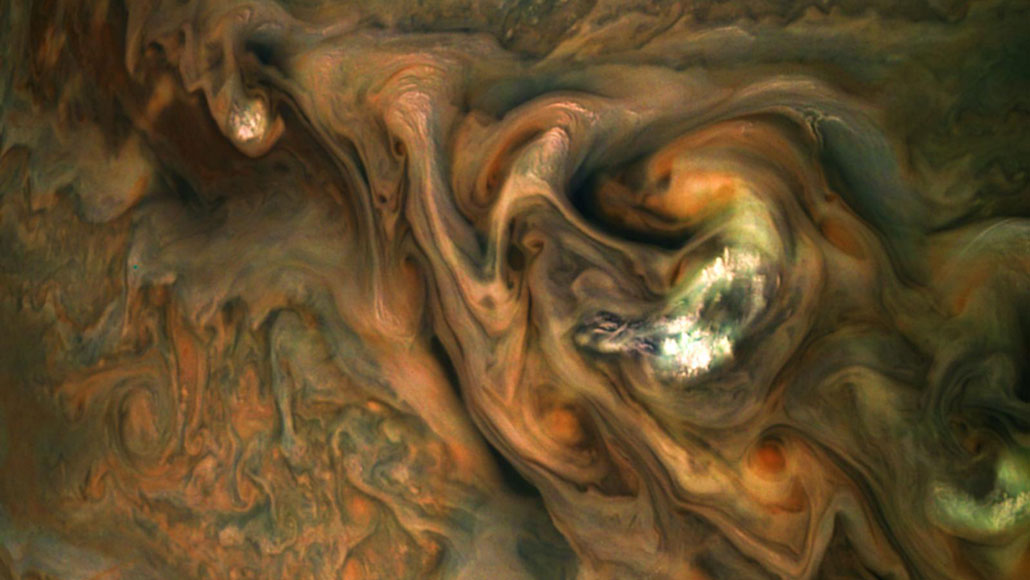Raindrops on alien worlds will obey Earth-like rules
Their size will be similar no matter what they’re made of or on which planet they fall

NASA’s Juno spacecraft took this image of swirling clouds on Jupiter. They could release semisolid, ammonia mushballs of precipitation. Research now suggests that in some ways any liquid rain on Jupiter would be similar to rain falling on any other cloudy world.
Gerald Eichstadt/MSSS/SwRI/JPL-Caltech/NASA
Raindrops behave much the same way across the Milky Way, a new analysis finds. This should hold whether we’re talking about a methane torrent on Saturn’s moon Titan or a drizzle of iron on the exoplanet WASP 78b. Regardless of what they’re made of, droplet sizes will always be close to the same size.
“You can get raindrops out of lots of things,” says Kaitlyn Loftus. She’s a planetary scientist at Harvard University in Cambridge, Mass. She and Harvard colleague Robin Wordsworth just published new equations to show what happens to a falling raindrop after it leaves a cloud. Their findings appear in the April JGR Planets.
Previous studies had looked at rain in specific cases. Perhaps it was the water cycle on Earth. Or it might have been methane rains on Saturn’s moon Titan. This analysis is the first to consider rain made of any liquid.
These authors “are proposing something that can be applied to any planet,” says astronomer Tristan Guillot. “That’s really cool,” he adds. He works at the Observatory of the Côte d’Azur. It’s in Nice, France.
Clouds can heat or cool a planet’s surface. Rains help move chemical elements and energy around and through the atmosphere. Scientists want to understand the atmospheres of other worlds, including their clouds and climate, And for that, Guillot notes, understanding rain size “is something that’s needed, really.”

Educators and Parents, Sign Up for The Cheat Sheet
Weekly updates to help you use Science News Explores in the learning environment
Thank you for signing up!
There was a problem signing you up.
Raindrops follow the law
Clouds are complex. Scientists don’t really understand how they grow and evolve, even on Earth. Raindrops, though, are governed by a few simple laws of physics. Falling drops of any liquid tend to take the same spherical shape. And the rate at which a droplet evaporates depends on its surface area.
“This is basically fluid mechanics and thermodynamics,” Loftus says. And those, she says, “we understand very well.”
She and Wordsworth considered a variety of different rains. This included water droplets on early Earth, on modern Mars and on a gaseous exoplanet called K2 18b. That last planet may host clouds of water vapor. The pair also considered Titan’s methane rain, ammonia “mushballs” on Jupiter and iron rain on an ultrahot gas giant exoplanet called WASP 76b. “All these different [rains] behave similarly,” she finds. That’s because they all must follow the same laws of physics.
Worlds where gravity is stronger tend to produce smaller raindrops, the pair found. Still, all the raindrops they analyzed fell within a narrow range. Their radius spanned only from about a tenth of a millimeter (a few thousandths of an inch) to a few millimeters. Droplets that get much bigger will break apart as they fall, Loftus and Wordsworth found. Much smaller drops, in contrast, may evaporate before hitting the ground (for planets that have a solid surface, anyway). That would keep this moisture in the atmosphere.
Eventually the researchers would like to extend the study to solid precipitation, such as snowflakes and hail. But it won’t be easy. The math to do that is much harder. “That adage that every snowflake is unique is true,” Loftus says.
This new study is a first step toward understanding precipitation in general, says Björn Benneke in Canada. He’s the University of Montreal astronomer who discovered water vapor in the atmosphere of K2 18b. Understanding alien atmospheres, he says, is “what we are all striving for.” Astronomers want to develop a fairly universal picture of how atmospheres and planets work. It’s important, he says, to “not just be completely Earth-centric.”







